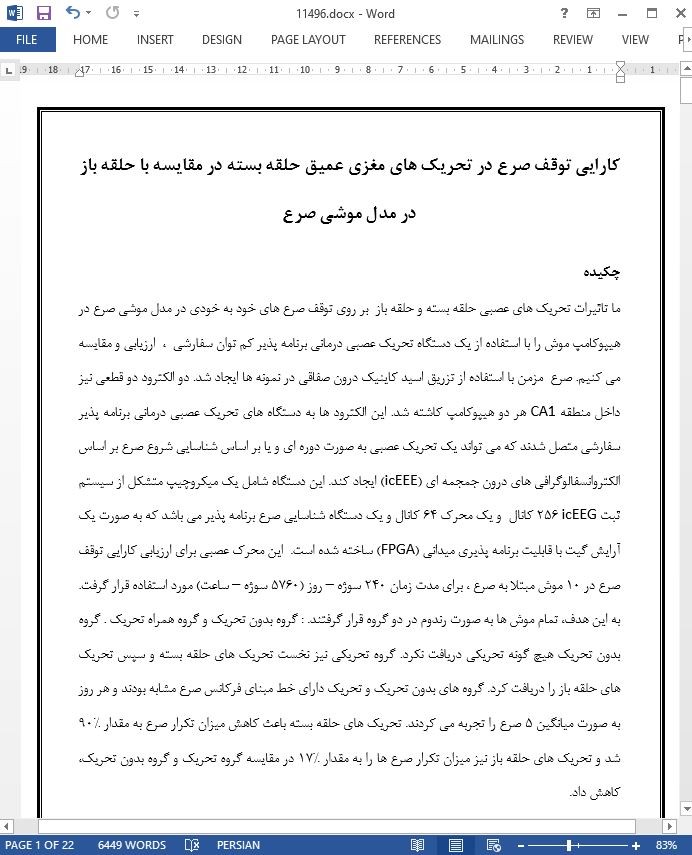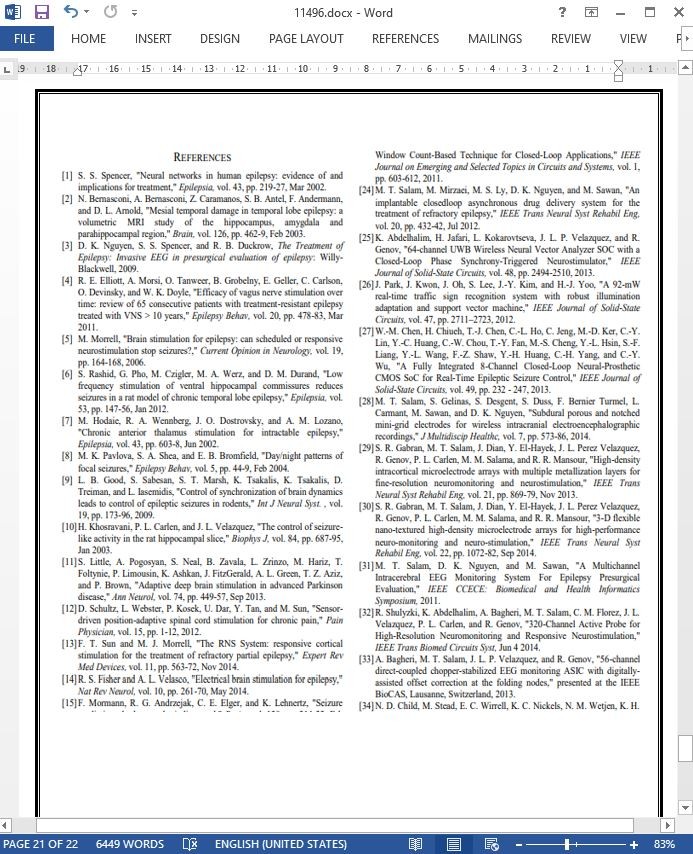
کارایی توقف صرع در تحریک های مغزی عمیق حلقه بسته در مقایسه با حلقه باز
چکیده
ما تاثیرات تحریک های عصبی حلقه بسته و حلقه باز بر روی توقف صرع های خود به خودی در مدل موشی صرع در هیپوکامپ موش را با استفاده از یک دستگاه تحریک عصبی درمانی برنامه پذیر کم توان سفارشی ، ارزیابی و مقایسه می کنیم. صرع مزمن با استفاده از تزریق اسید کاینیک درون صفاقی در نمونه ها ایجاد شد. دو الکترود دو قطعی نیز داخل منطقه CA1 هر دو هیپوکامپ کاشته شد. این الکترود ها به دستگاه های تحریک عصبی درمانی برنامه پذیر سفارشی متصل شدند که می تواند یک تحریک عصبی به صورت دوره ای و یا بر اساس شناسایی شروع صرع بر اساس الکتروانسفالوگرافی های درون جمجمه ای (icEEE) ایجاد کند. این دستگاه شامل یک میکروچیپ متشکل از سیستم ثبت icEEG 256 کانال و یک محرک 64 کانال و یک دستگاه شناسایی صرع برنامه پذیر می باشد که به صورت یک آرایش گیت با قابلیت برنامه پذیری میدانی (FPGA) ساخته شده است. این محرک عصبی برای ارزیابی کارایی توقف صرع در 10 موش مبتلا به صرع ، برای مدت زمان 240 سوژه – روز (5760 سوژه – ساعت) مورد استفاده قرار گرفت. به این هدف، تمام موش ها به صورت رندوم در دو گروه قرار گرفتند. : گروه بدون تحریک و گروه همراه تحریک . گروه بدون تحریک هیچ گونه تحریکی دریافت نکرد. گروه تحریکی نیز نخست تحریک های حلقه بسته و سپس تحریک های حلقه باز را دریافت کرد. گروه های بدون تحریک و تحریک دارای خط مبنای فرکانس صرع مشابه بودند و هر روز به صورت میانگین 5 صرع را تجربه می کردند. تحریک های حلقه بسته باعث کاهش میزان تکرار صرع به مقدار 90% شد و تحریک های حلقه باز نیز میزان تکرار صرع ها را به مقدار 17% در مقایسه گروه تحریک و گروه بدون تحریک، کاهش داد.
6. جمع بندی
این مطالعه ، نشان دهنده ابعاد مهندسی مرتبط با کنترل تشنج صرعی موثر می باشد و یک دستگاه تحریک عصبی درمانی برای درمان صرع مقاوم را ارائه می کند. نتایج این مطالعه با استفاده از یک دستگاه تحریک عصبی درمانی سفارشی نشان می دهد که با استفاده از یک روش تحریک حلقه بسته می توان به صورت محسوس میزان تشنج ها را کاهش داد ( کاهش 90% در تعداد تشنج ها) ، در حالی که سیستم های حلقه باز باعث کاهش 17% می شوند. این کارایی توقف تشنج در نتیجه ایجاد یک تحریک درست قبل از شکل گیری تشنج می باشد که در واکنش به شناسایی الگوهای غیر عادی از icEEG شکل می گیرد ، در حالی که سیستم حلقه باز تحریک ها را به صورت دوره ای ایجاد می کند. ازین رو، استراتژی های حلقه بسته باعث افزایش کارایی تحریک ها شده و در عین حال، عوارض جانبی تحریک ها را هم کاهش می دهد زیرا از کمترین تعداد تحریک ممکن استفاده می کند. ازین رو یکی از روش های جایگزین مناسب برای تحریک کننده های عصبی حلقه باز، استفاده از سیستم های حلقه بسته می باشد که در آن ها ، میزان تحریک های عمیق مغزی به کمترین تعداد ممکن می رسد. به عنوان توسعه کار های موجود در رابطه با صرع، حوزه جدید استراتژی های تحریک عمیق مغزی مبتنی بر سیستم های حلقه بسته را می توان بررسی کرد تا ابعاد مختلف آسیب شناسی فعالیت های مغزی برای درمان بیماری های مختلف عصبی را کشف نمود.
Abstract
We assess and compare the effects of both closedloop and open-loop neurostimulation of the rat hippocampus by means of a custom low-power programmable therapeutic neurostimulation device on the suppression of spontaneous seizures in a rodent model of epilepsy. Chronic seizures were induced by intraperitoneal kainic acid injection. Two bipolar electrodes were implanted into the CA1 regions of both hippocampi. The electrodes were connected to the custom-built programmable therapeutic neurostimulation device that can trigger an electrical stimulation either in a periodic manner or upon detection of the intracerebral electroencephalographic (icEEE) seizure onset. This device includes a microchip consisting of a 256-channel icEEG recording system and a 64-channel stimulator, and a programmable seizure detector implemented in a field-programmable gate array (FPGA). The neurostimulator was used to evaluate seizure suppression efficacy in 10 epileptic rats for a total of 240 subject-days (5760 subject-hours). For this purpose, all rats were randomly divided into two groups: the nostimulation group and the stimulation group. The no-stimulation group did not receive stimulation. The stimulation group received, first, closed-loop stimulation and, next, open-loop stimulation. The no-stimulation and stimulation groups had a similar seizure frequency baseline, averaging five seizures per day. Closed-loop stimulation reduced seizure frequency by 90% and open-loop stimulation reduced seizure frequency by 17%, both in the stimulation group as compared to the no-stimulation group.
VI. CONCLUSION
This study demonstrates engineering aspects associated with the effective epileptic seizure control and proposes a therapeutic neurostimulation device for the treatment of refractory epilepsy. The results of this study using a custombuilt therapeutic neurostimulation device reveal a greater efficiency at reducing ictal events (90% seizure frequency suppression) using a closed-loop stimulation method, whereas the open-loop resulted in a 17% reduction. This seizure suppression efficacy is achieved as a result of triggering a stimulation just before a seizure development, in response to an abnormal icEEG pattern detection; whereas the open-loop system delivers stimulations periodically. Thus, the closedloop strategy increases efficiency of the stimulations, while reducing the possible side effects using the minimum number of stimulations as required. Therefore, an effective alternative to the open-loop neurostimulator is the closedloop neurostimulator, in which the involvement of the deep brain stimulation is minimal. As an extension of the work on epilepsy, the new era of deep brain stimulation strategies based on closed-loop paradigms may be able to target different pathological aspects of brain activity for the treatment of various neurological disorders.
چکیده
1. مقدمه
2. روش ها و مواد
الف) حیوانات
ب) القای صرع مزمن
ج) کاشت الکترود ها
د) تحریک عصبی
ه . نظارت ویدئویی EEG 24 ساعته
و. پارامتر های تحریک الکتریکی
ز. فرایند آزمایش تحریک عصبی
ز. تحلیل داده های آماری
3. نتایج
4. تحریک با مصرف انرژی کم
5. مباحث
الف) تنظیم پارامتر های تحریک
ب) کارایی بالای تحریک های حلقه بسته
ج) تعداد تحریک ها و طول عمر باتری
د) عوارض جانبی کمتر
6. جمع بندی
Abstract
I. INTRODUCTION
II. METHODS AND MATERIALS
A. Animals
B. Chronic Seizure Induction
C. Electrode Implantation
D. Neurostimulator
E. 24-Hour Video-EEG Monitoring
F. Electrical Stimulation Parameters
G. Neurostimulation Experimental Procedure
H. Statistical Data Analysis
III. RESULTS
IV. ENERGY EFFICIENT STIMULATION
V. DISCUSSION
A. Stimulation Parameter Adjustment
B. High Efficiency of Closed-loop Stimulation
C. Number of Stimulations and Battery Lifetime
D. Less Adverse Effects
VI. CONCLUSION
- اصل مقاله انگلیسی با فرمت ورد (word) با قابلیت ویرایش
- ترجمه فارسی مقاله با فرمت ورد (word) با قابلیت ویرایش، بدون آرم سایت ای ترجمه
- ترجمه فارسی مقاله با فرمت pdf، بدون آرم سایت ای ترجمه



